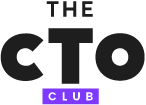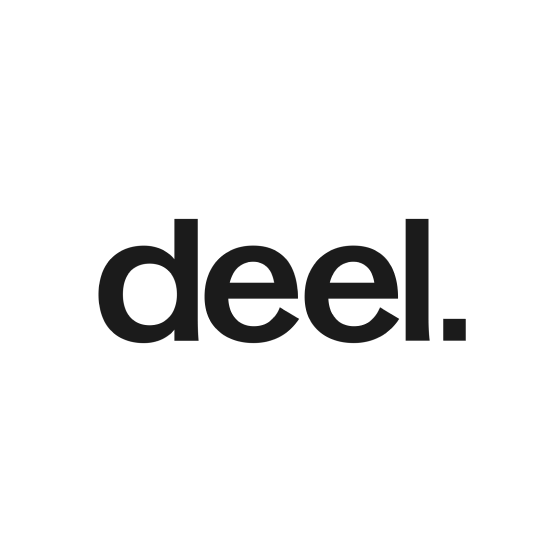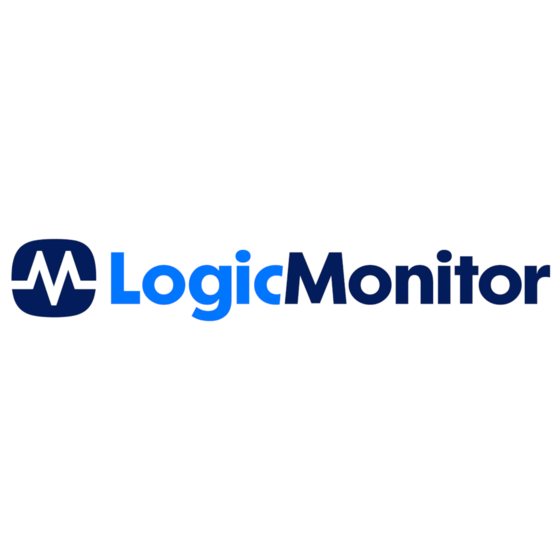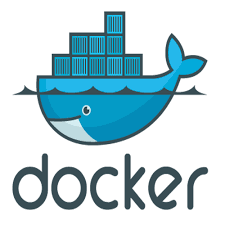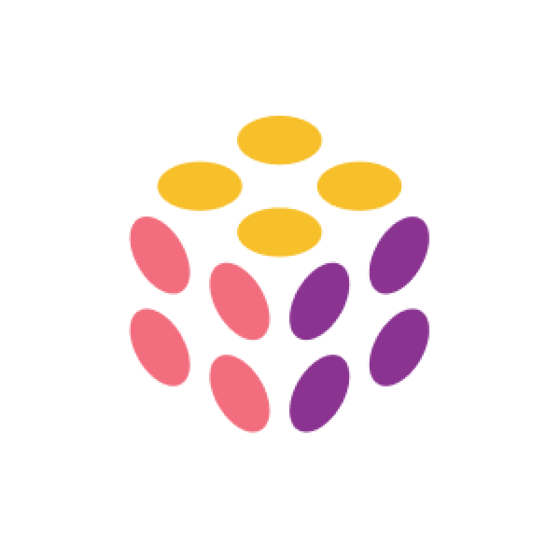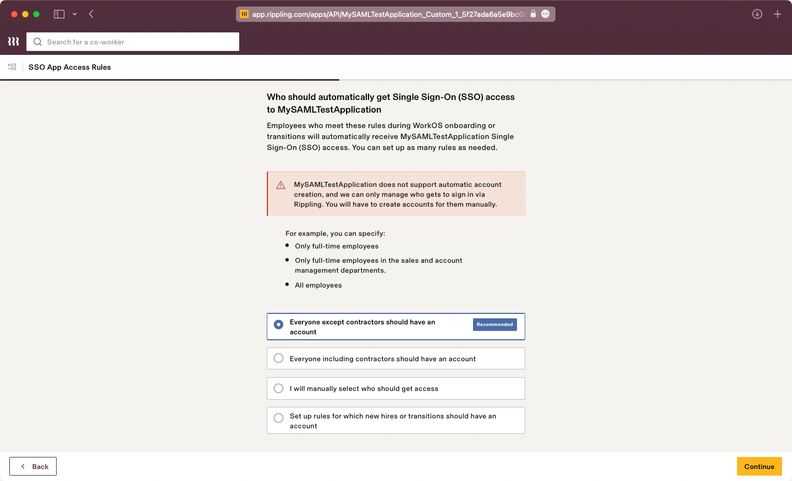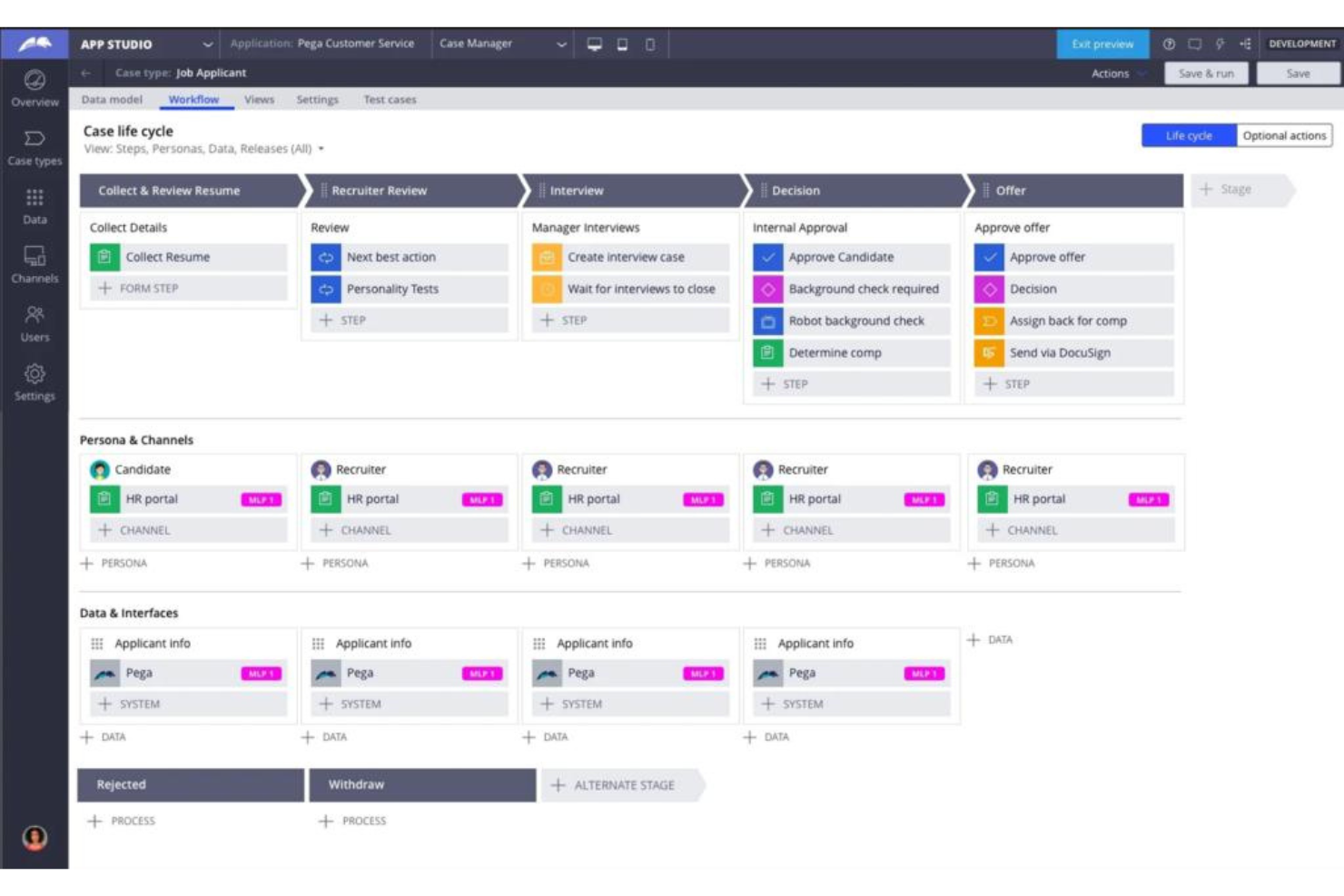10 Best IT Process Automation Software Shortlist
Here’s my shortlist of the best IT process automation software:
Our one-on-one guidance will help you find the perfect fit.
Navigating the intricate maze of IT processes can be daunting, and I've been wrestling with the complexity, just like you. IT process automation software is your co-pilot, precisely steering tasks and operations. With this tool, you're not just simplifying tasks; you're transforming your entire IT workflow.
Think of all those repetitive tasks, time-consuming data entries, and the tricky coordination of IT tasks - this software is your answer to all those pain points. I've sifted through the noise to bring you options that resonate with your needs. Dive in, and let's find the perfect fit for you.
Why Trust Our Software Reviews
We’ve been testing and reviewing SaaS development software since 2023. As tech experts ourselves, we know how critical and difficult it is to make the right decision when selecting software. We invest in deep research to help our audience make better software purchasing decisions.
We’ve tested more than 2,000 tools for different SaaS development use cases and written over 1,000 comprehensive software reviews. Learn how we stay transparent & check out our software review methodology.
Best IT Process Automation Software Summary
This comparison chart summarizes pricing details for my top IT process automation software selections to help you find the best one for your budget and business needs.
| Tool | Best For | Trial Info | Price | ||
|---|---|---|---|---|---|
| 1 | Best for automated global asset management | Free trial + demo available | From $29/month | Website | |
| 2 | Best for ease of use with pre-built integrations, job steps, and templates | Free demo available | Pricing upon request | Website | |
| 3 | Best for automating IT onboarding | Free trial available | From $8/user/month (billed annually) | Website | |
| 4 | Best for drag-and-drop application building | Free demo available | Pricing upon request | Website | |
| 5 | Best for document management automation | Free demo available | Pricing upon request | Website | |
| 6 | Best for CRM and process automation fusion | Free trial available | From $25/user/month (billed annually) | Website | |
| 7 | Best for connecting and automating SAP and non-SAP systems and workflows | Free demo available | Pricing upon request | Website | |
| 8 | Best for infrastructure monitoring automation | Free trial available | From $3/resource/month | Website | |
| 9 | Best for low-code automation and integration | Free plan available | Pricing upon request | Website | |
| 10 | Best for AI-driven decision automation | Not available | Pricing upon request | Website |
-

Docker
Visit WebsiteThis is an aggregated rating for this tool including ratings from Crozdesk users and ratings from other sites.4.6 -

Pulumi
Visit WebsiteThis is an aggregated rating for this tool including ratings from Crozdesk users and ratings from other sites.4.8 -

GitHub Actions
Visit Website
Best IT Process Automation Software Reviews
Below are my detailed summaries of the best IT process automation software that made it onto my shortlist. My reviews offer a detailed look at the key features, pros & cons, integrations, and ideal use cases of each tool to help you find the best one for you.
Deel is widely known for its comprehensive HR, payroll, and compliance solutions, but its IT suite, Deel IT, adds another layer of innovation by integrating global IT operations management into its platform. With the rise of remote and hybrid workforces, Deel offers businesses the ability to manage not just their people, but also their IT assets, across more than 130 countries.
Why I Picked Deel: For businesses operating in multiple regions, Deel’s automated workflows for onboarding and offboarding employees stand out. It can pre-configure devices with apps, and security protocols, and ship them globally, ensuring employees are set up from day one. Furthermore, Deel provides complete visibility over all assets worldwide, automating tracking and recovery, which is crucial for managing large inventories spread across different countries.
Standout features & integrations
One standout feature is Deel’s 24/7 global IT support, which ensures that teams are always online and productive. The platform also offers SLA-backed repairs and sends loaner devices when needed, minimizing downtime. Another convenient feature is its certified data erasure service, which secures company data when devices are returned or re-deployed.
Integrations include Slack, Google Workspace, Microsoft Teams, BambooHR, Greenhouse, SAP SuccessFactors, Okta, and Azure Active Directory.
Pros and cons
Pros:
- Supports equipment deployment in over 130 countries
- Can combine HR and IT asset management in one
- Can pre-configure devices before they're shipped
Cons:
- May not be ideal for teams with very complex IT asset needs
- Doesn't offer features beyond device management, like network and server management
New Product Updates from Deel

Deel Launches Anytime Pay Beta for Daily Earnings Access
Deel introduced an Anytime Pay beta, allowing EOR workers with Deel Cards to withdraw earned pay daily. Automatic tax and ledger updates are included, with PEO and Global Payroll support coming soon. More details at Deel Blog.
Best for ease of use with pre-built integrations, job steps, and templates
ActiveBatch is an IT automation tool designed to build, monitor, and manage end-to-end workflows across various technology platforms. It provides a centralized automation hub for scheduling and monitoring, enabling business-critical systems to work together with minimal human intervention. It's designed to integrate seamlessly with your current tech stack for less disruption to existing workflows.
Why I Picked ActiveBatch: The tool features a low-code drag-and-drop graphical user interface for easy setup and management of workflows, ideal for team members without advanced development skills. The software also has a comprehensive library of prebuilt integrations and extensions, job steps, templates, and advanced scheduling capabilities. ActiveBatch also leverages artificial intelligence (AI) and machine learning (ML) to optimize resources and workload placement.
Standout features & integrations
ActiveBatch has features for a wide range of IT and business processes, including job scheduling, event automation, cloud provisioning, and service-level agreement management. It also offers security, auditing, and governance features to ensure controlled access across environments.
Integrations include Active Directory, Crystal Reports, CyberArk Application Access Manager, Exchange Server, JSCAPE Managed File Transfer, Oracle Job Scheduler, PowerShell, SQL Server Scheduling, and more.
Pros and cons
Pros:
- Scalability and intelligent automation features
- Event-based automation
- Real-time processes and accurate data capturing capabilities
Cons:
- Could be easier to setup
- Some features in the user interface may be confusing
Rippling IT is an end-to-end IT management platform designed to help businesses manage their IT operations efficiently. It offers solutions for device management, identity and access control, and inventory oversight, all within a single system.
Why I Picked Rippling IT: I like its automated onboarding and offboarding processes. When a new employee joins, the platform can automatically order and ship devices, create user accounts, and assign appropriate access levels based on their role. This ensures that new hires have the necessary tools from day one, reducing delays and administrative effort. Similarly, when an employee leaves, Rippling IT can revoke access, lock and wipe devices, and manage the return of equipment.
Standout features & integrations
The platform also allows you to set up custom workflows to automate routine IT tasks, such as software installations, security policy enforcement, and device configurations. It even includes inventory tracking and logistics, which provide visibility into every device's status and automate the shipping, storage, and retrieval process.
Integrations include Slack, Microsoft Teams, Zoom, Google Workspace, QuickBooks Online, Xero, Salesforce, GitHub, Jira, HubSpot, Datadog, and PayPal.
Pros and cons
Pros:
- Customizable workflow automation
- Support for onboarding and offboarding employees and their devices
- Remote device lock and wipe capabilities
Cons:
- Can be complex to set up initially
- Not all features may be necessary for smaller operations
New Product Updates from Rippling IT
Assign Identity Providers by Team with Rippling IT
Rippling IT now allows assigning specific identity providers like Okta and Entra ID to different teams, with Rippling’s SSO as a backup for instant rollbacks. More details at Rippling Blog.
Quixy is a modern cloud-based platform designed to simplify the process of building business applications without coding. With its drag-and-drop interface, users can quickly create applications tailored to their unique business needs. It is especially beneficial for those who want an uncomplicated method to build applications.
Why I Picked Quixy: When I was sifting through various automation tools and platforms, Quixy's drag-and-drop capability immediately stood out. It's a platform that truly empowers business users to take matters into their own hands without the need to rely on heavy IT intervention. I selected it for this list because of its unparalleled user-friendly interface, which perfectly aligns with the need for effortless application building.
Standout features & integrations
One of Quixy's most noteworthy features is its intuitive user interface that allows for easy drag-and-drop operations, reducing manual tasks and the potential for human error. Alongside, its cloud-based architecture ensures accessibility from anywhere. In terms of integrations, Quixy is versatile. It has connectors for various platforms like Salesforce, Microsoft products, and also provides an API for custom integrations, allowing businesses to link with tools they're already familiar with.
Pros and cons
Pros:
- Cloud-based infrastructure ensures global accessibility and ease of updates.
- Strong integration capabilities, from pre-built connectors to custom APIs.
- Intuitive drag-and-drop interface making application building straightforward.
Cons:
- Potential learning curve for users completely new to application building.
- Lack of transparent pricing can be a barrier for some organizations.
- The simplicity might not cater to businesses looking for more intricate features.
Laserfiche is a powerful automation tool specifically designed to streamline and improve document management processes. By emphasizing automated workflows centered around document handling, it addresses the challenges businesses face with manual document procedures and ensures more efficient business process management.
Why I Picked Laserfiche: Laserfiche immediately captured my attention when selecting a tool for this list because of its dedicated focus on document automation. I judged it against several other contenders and it was evident that Laserfiche's capabilities in automating document-centric tasks were unparalleled. This made my decision clear as to why it stands out as the best for document management automation.
Standout features & integrations
Laserfiche is more than just a document repository. It offers features like automated workflows, permissions management, and real-time notifications to keep team members in sync.
When it comes to integrations, Laserfiche is compatible with a variety of tools and platforms. It supports connectors for mainstream platforms such as Microsoft, Salesforce, and ERP systems, ensuring that document processes can be embedded into broader business workflows.
Pros and cons
Pros:
- Permissions management ensures that sensitive documents remain secure and accessible only to authorized personnel.
- Comprehensive set of integrations, ensuring compatibility with major platforms.
- Strong emphasis on document-centric automated workflows.
Cons:
- Absence of transparent pricing can create uncertainties for businesses planning their budgets.
- The initial setup can be complex for those unfamiliar with document management systems.
- The specificity of the tool might not appeal to businesses looking for a more generalized automation solution.
Creatio is a platform that combines CRM features with process automation. It helps businesses improve customer relations and optimize internal workflows in harmony with the CRM.
Why I Picked Creatio: In my journey of selecting tools, Creatio emerged as a compelling choice. The fusion of CRM capabilities with process automation tools is what genuinely differentiates it from the competition. I determined that for businesses looking to unify customer management and automated workflows, Creatio stands as the ideal solution. This is why I believe it truly fits the bill as the 'Best for CRM and process automation fusion'.
Standout features & integrations:
Creatio comes equipped with a user-friendly interface, easing the navigation between CRM functionalities and business process automation. Automated workflows can be tailored using templates to suit specific business needs, while its BPM features ensure real-time tracking of processes.
When it comes to integrations, Creatio boasts connectors with Microsoft, Salesforce, and also supports integration with Zapier, ensuring businesses have a wide range of tools at their disposal.
Pros and cons
Pros:
- Real-time BPM tools for tracking and refining workflows
- Extensive integration options, including major players like Microsoft and Salesforce
- Dual functionality of CRM and process automation in a single platform
Cons:
- While it offers a broad feature set, mastering all of them requires dedicated onboarding.
- Certain niche integrations might require custom scripting
- The dual functionality might seem overwhelming to first-time users
Best for connecting and automating SAP and non-SAP systems and workflows
RunMyJobs is a SaaS-based workload automation platform that provides solutions for enterprise workload, file transfer, and finance automation. It is designed to integrate with SAP ERP applications and S/4HANA Cloud, as well as other business processes for real-time results.
Why I Picked RunMyJobs: As an IT process automation software, the platform enables full-stack automation for businesses, allowing users to connect to any app, system, or service with prebuilt integrations and automate processes across applications, servers, and services. RunMyJobs is designed to work on-premises, in the cloud, or in hybrid environments. It also provides end-to-end visibility and control, real-time monitoring, and predictive SLA notification to ensure that issues are quickly identified and resolved. Another standout aspect of RunMyJobs is that it's a premium-certified SAP Endorsed App and is included in the RISE with SAP reference architecture, making it ideal for those looking for less risk and long-term reliability.
Standout features & integrations
RunMyJobs offers event-based automation, which triggers a process based on real-time events. It also has record-to-report automation to eliminate manual tasks in accounting processes. Other notable features include data management, DevOps automation, and ETL automation.
The platform integrates with SAP ERP, SAP S/4HANA, Oracle, Datasphere, Databricks, Box, ServiceNow, Amazon S3, Azure, Boomi, Snowflake, SharePoint, and more.
Pros and cons
Pros:
- Customizable batch scheduling
- Ability to schedule and monitor jobs
- Notification and alerting functionality
Cons:
- Dashboard could be improved
- Complexity for inexperienced users
LogicMonitor stands as a specialized tool for companies aiming to automate the monitoring of their infrastructure. Through its cloud-based interface, it offers businesses in-depth insights into the health and status of their infrastructure, aligning perfectly with the need for infrastructure monitoring automation.
Why I Picked LogicMonitor: After evaluating and comparing several automation tools, I chose LogicMonitor based on its specific focus on infrastructure. Its unique offering and user interface for infrastructure monitoring set it apart from other automation solutions. In my judgment and based on various use cases, I believe LogicMonitor is particularly tailored to be 'Best for infrastructure monitoring automation' because of its comprehensive and automated insights into IT infrastructure.
Standout features & integrations
LogicMonitor boasts automated workflows to detect and alert on issues in real-time, ensuring minimal human error in tracking infrastructure problems. It also offers a user-friendly dashboard to read metrics, enabling quick decisions.
Integrations-wise, LogicMonitor connects effortlessly with platforms like Microsoft, Salesforce, and even Zapier, allowing for a flow of data and alerts across various tools.
Pros and cons
Pros:
- Extensive integrations with popular platforms to improve functionality.
- Real-time alerts and notifications reduce response time to issues.
- Specific focus on infrastructure monitoring ensures specialized features.
Cons:
- The depth of features may pose a learning curve for some users.
- Might be over-specialized for businesses not entirely focused on infrastructure.
- Lack of transparent pricing can make budget planning challenging.
Appian offers a leading low-code automation platform that empowers businesses to create apps quickly and with minimal hands-on coding. By enabling businesses to integrate their systems and automate workflows, Appian plays a vital role in simplifying complex processes and promoting efficient business process management.
Why I Picked Appian: In my quest to identify impactful automation tools, I determined that Appian stood out prominently in the realm of low-code platforms. I chose it because of its unique blend of user-friendly interfaces coupled with powerful automation capabilities. This juxtaposition of simplicity and power underpins why it's the best for those who need low-code automation and deep integration capabilities.
Standout features & integrations
Appian's low-code platform is not just about building applications swiftly; it's about ensuring they can interact with other systems. The platform offers connectors for significant platforms such as Salesforce and Microsoft, enabling businesses to establish automated workflows across various software. Its robust API infrastructure also paves the way for in-depth custom integrations, addressing diverse business needs.
Pros and cons
Pros:
- Focus on both automation and integration ensures a holistic approach to business process automation.
- Comprehensive integration capabilities, including both pre-built connectors and custom API options.
- Intuitive low-code platform that reduces time-consuming manual coding.
Cons:
- Lack of transparent pricing can make budgeting challenging for some businesses.
- The platform's wide range of features may be overwhelming for new users.
- Some complex integrations might require a steeper learning curve.
Pega Platform is a dynamic automation tool incorporating AI technology to refine organizational decision-making processes. Leveraging AI algorithms and data analytics facilitates smarter business decisions, aligning perfectly with its reputation as the best choice for AI-driven decision automation.
Why I Picked Pega Platform: In the process of selecting and judging various automation solutions, Pega Platform consistently emerged as a front-runner. Its AI capabilities are not just a peripheral addition but are deeply integrated, making the platform truly distinctive. When considering tools for AI-driven decision automation, Pega's in-depth AI capabilities and its reputation in the industry convinced me of its superiority.
Standout features & integrations
Pega Platform excels with its AI-driven automated workflows, allowing businesses to reduce human error and speed up decision-making processes. The platform is designed with a user-friendly interface, offering BPM and BPA features that streamline business process management.
Integration-wise, Pega offers connectors to major platforms such as Salesforce, Microsoft, and even has the ability to work with Zapier, allowing for a plethora of real-time data connections.
Pros and cons
Pros:
- Rich integration ecosystem with key platforms and tools.
- Comprehensive BPM and BPA features to improve workflow management.
- Advanced AI algorithms integrated into the core of the platform.
Cons:
- Might be overkill for businesses looking for simpler automation solutions.
- A steeper learning curve might be expected given its vast feature set.
- Some businesses might find its extensive AI capabilities overwhelming initially.
Other IT Process Automation Software
Here are some additional lT process automation software options that didn’t make it onto my shortlist, but are still worth checking out:
- Kissflow
For simple workflow creation and management
- Josys
For automating SaaS provisioning tasks
- NewgenONE Digital Transformation Platform
For end-to-end digital solutions
- Zvolv
For rapid no-code application development
- Nintex Process Platform
For process mapping and visualization
- Advsyscon
For IT workload automation
- Parallel
For real estate business automation
- NinjaOne
For endpoint management and patch compliance
- Atera
For automating patching & routine IT tasks
- SuperOps
For MSP operational growth
- AppMaster
Good for creating apps without technical expertise
- Superblocks
Good for blockchain and smart contract projects
- ProcessMaker
Good for BPMN 2.0 compliant workflows
- TrackVia
Good for mobile workflow and data tracking
- Checkbox
Good for automating legal processes
- BP Logix
Good for predictive process modeling and management.
- Nintex Automation On-Prem (formerly K2 Software)
Good for on-premises automation deployment
- FlowForma Process Automation
Good for digital process automation without coding
- Tonkean
Good for adaptive business operations
- BRYTER
Good for no-code business application building
- PMG Platform
Good for rapid digital transformation initiatives
- Kofax TotalAgility
Good for multi-channel capture and process management
- SS&C Blue Prism Intelligent Automation Platform
Good for scalable robotic process automation
- Catalytic
Good for efficient process and data integration
- AgilePoint NX
Good for model-driven application development
Related Reviews
IT Process Automation Software Selection Criteria
When it comes to selecting IT process automation software, the sheer variety of options can be overwhelming. I've evaluated dozens of these tools, putting emphasis on functionalities that cater specifically to the needs of IT professionals. For this guide, my main focus was on robust orchestration capabilities and efficient process automation platforms, which I'll delve into below.
Core Functionality
- RPA Integration: Integration with Robotic Process Automation (RPA) solutions to facilitate automated tasks without manual intervention.
- Process Orchestration: Ability to automate and coordinate complex workflows across multiple applications and platforms.
- Data Entry Automation: Tools that eliminate the manual, time-consuming processes of entering and updating data across systems.
- Human Resources Automation: Efficiently manage HR-related processes, including employee onboarding, role assignments, and benefits administration.
- Customer Experience Enhancement: Features that assist in streamlining and improving the journey of customers, from ticketing systems to feedback loops.
Key Features
- Routing Capabilities: Directing processes or tasks to appropriate channels or teams, ensuring timely responses and actions.
- Bot Deployments: The use of bots to carry out repetitive tasks, improving efficiency, especially in areas like customer service via social media platforms.
- Security Protocols: Strong encryption and security measures to protect sensitive data and ensure only authorized personnel have access.
- Customizable Templates: Pre-built templates that can be tailored to specific organizational needs, speeding up the setup process.
- Real-time Analytics: Offering in-depth insights into automation performance, helping identify areas for improvement.
Usability
- Intuitive Interface: For IT process automation tools, a dashboard that visualizes complex workflows and allows for easy adjustments is essential. Features like drag-and-drop functionality can significantly simplify the orchestration process.
- Role-based Access: Especially vital for larger teams or complex enterprise solutions, ensuring that only relevant team members can modify or view certain processes or data.
- Onboarding and Training: Given the intricate nature of IT processes, having a comprehensive learning library, wiki, or training program is critical. This ensures that all users, whether beginners or advanced, can utilize the tool to its full potential.
- Responsive Customer Support: For any technical hiccups or advanced customization needs, having a dedicated support team that's knowledgeable and timely in their responses can make all the difference.
The key lies in recognizing the specific needs of your organization and aligning them with a tool that excels in those areas. The right automation tool can significantly improve efficiency, reduce errors, and provide insights for continuous improvement.
How to Choose IT Process Automation Software
It’s easy to get bogged down in long feature lists and complex pricing structures. To help you stay focused as you work through your unique software selection process, here’s a checklist of factors to keep in mind:
| Factor | What to Consider |
|---|---|
| Scalability | Will the tool still fit if your team or data volume doubles in the next year? |
| Integrations | Does it connect easily with your current tech stack (e.g., Jira, Slack, ServiceNow)? |
| Customizability | Can you adjust workflows to match how your team actually works, without dev work? |
| Ease of use | Will your team need training, or can they figure it out with minimal guidance? |
| Implementation and onboarding | How long does setup take, and who on your team needs to be involved? |
| Cost | Is pricing based on users, tasks, or something else—and how fast can that scale up? |
| Security safeguards | Does it support SSO, audit logs, and role-based access for sensitive workflows? |
| Compliance requirements | Does it meet standards like SOC 2, ISO 27001, or others your industry requires? |
What Is an IT Process Automation Software?
IT process automation software is a technological solution designed to automate repetitive tasks, streamline workflows, and improve the efficiency of IT operations. Organizations, ranging from startups to large enterprises, employ this software to ensure smooth and consistent execution of IT processes, reduce manual interventions, and improve accuracy. Typically used by IT managers, system administrators, and operation teams, these tools facilitate tasks such as server provisioning, software updates, and system monitoring, enabling businesses to focus on strategic initiatives and drive growth.
Features of IT Process Automation Software
When selecting IT Process Automation Software, keep an eye out for the following key features:
- Workflow automation: Automates repetitive IT tasks like ticket routing or user provisioning.
- Event-based triggers: Kicks off workflows automatically in response to system alerts or changes.
- Drag-and-drop builder: Lets you build and update workflows without writing code.
- Integration support: Connects with your existing tools like ITSM platforms, CRMs, and monitoring tools.
- Role-based access controls: Restricts who can view, edit, or run specific workflows.
- Audit trails: Tracks who did what and when for security and compliance purposes.
- Error handling and alerts: Notifies your team when an automated task fails or needs attention.
- Scheduling options: Lets you run tasks at set times, intervals, or based on conditions.
- Reporting and analytics: Gives insights into workflow performance, time savings, and bottlenecks.
- Template library: Offers prebuilt workflows to help your team get started faster.
Benefits of IT Process Automation Software
Implementing IT Process Automation Software provides several benefits for your team and your business. Here are a few you can look forward to:
- Fewer manual tasks: Automates repetitive jobs like password resets so your team can focus on bigger issues.
- Faster response times: Kicks off actions the moment alerts come in, helping you fix problems sooner.
- Lower error rates: Reduces the risk of mistakes by running consistent, rule-based workflows.
- Better use of resources: Lets you get more done with the same headcount by automating routine work.
- Easier compliance tracking: Keeps records of who did what and when so you’re always audit-ready.
- Clearer performance insights: Shows you which workflows are working and where things get stuck.
- Improved team coordination: Keeps everyone on the same page by triggering updates or handoffs automatically.
Costs and Pricing of IT Process Automation Software
Selecting IT Process Automation Software requires an understanding of the various pricing models and plans available. Costs vary based on features, team size, add-ons, and more. The table below summarizes common plans, their average prices, and typical features included in IT Process Automation Software solutions:
Plan Comparison Table for IT Process Automation Software
| Plan Type | Average Price | Common Features |
|---|---|---|
| Free Plan | $0 | Basic automation templates, limited workflows, and community support. |
| Personal Plan | $10–$20/ user/month | Custom workflows, basic analytics, email support, and integration with a few third-party apps. |
| Business Plan | $25–$50/ user/month | Unlimited workflows, advanced analytics, API access, role-based access, and priority support. |
| Enterprise Plan | $60–$100/ user/month | Custom SLAs, on-premise deployment, compliance tools, advanced security options, and dedicated support. |
IT Process Automation Software FAQs
Here are some answers to common questions about IT process automation software:
How do you evaluate IT process automation tools?
Start by looking at your team’s current workflows and where the bottlenecks are. Then, match those needs against features like workflow builders, integrations, and reporting. Consider ease of use, pricing, and how well the tool fits into your existing tech stack. Always try a free trial or demo if it’s offered.
Can small teams benefit from IT process automation?
Yes, even small teams can get a lot of value from automation. It helps cut down on manual tasks, avoid errors, and keep things moving without needing more headcount. Look for tools with simple UI and basic plans designed for smaller users. Many platforms scale as your team grows.
What’s the difference between IT automation and orchestration?
Automation handles single tasks or scripts, like resetting a password. Orchestration manages a whole workflow of tasks across tools and systems. If your processes involve multiple steps or tools, you’ll probably need both. Some platforms offer both in one.
How do you ensure security in automated IT workflows?
Use tools with built-in role-based access and audit logging. Make sure sensitive steps (like software installs or credential handling) are locked down. Your team should also review automation scripts regularly and follow internal security policies. Choosing a tool with compliance certifications helps too.
Can IT process automation work across different departments?
Yes, it can support teams outside of IT—like HR, finance, and customer service. Many tools allow you to build workflows for things like onboarding, approvals, or asset tracking. Just make sure the tool you choose supports cross-functional use and integrations with non-IT systems.
How hard is it to switch from manual processes to automated ones?
It depends on your setup, but most teams need a few weeks to fully switch over. Start small with high-impact tasks, and use templates or drag-and-drop builders to save time. Make sure everyone is trained and knows how to tweak workflows if something changes.
What do you think?
Absolutely, this space is ever-evolving with new tools emerging regularly. So, if there's an IT process automation software that you've encountered, that you believe deserves a spotlight and I haven't mentioned, please do share it with me. I'm always eager to learn from the community and expand my horizons. Your suggestions and insights are invaluable in making this guide comprehensive and up-to-date. Let's collaborate and ensure everyone has access to the best tools in the market!
